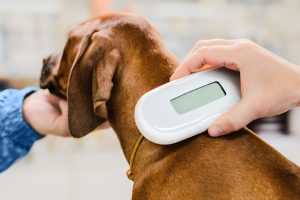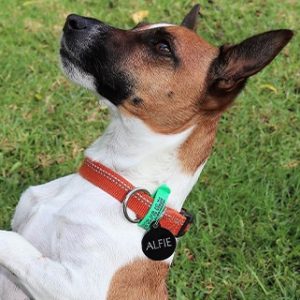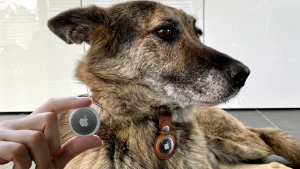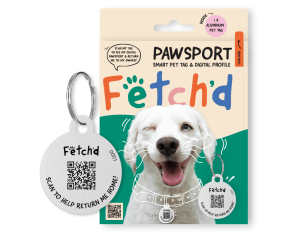As pet parents, we know that having our beloved companion animals go missing is one of the worst feelings we can experience. Like any family member, we want to keep our pets safe, happy, and free from harm. Still, animals have their own instincts, and sometimes, their curiosity gets the better of them, and they escape to the great outdoors.
Even when we take steps to provide our pets with ID, we need help understanding exactly how they work. For example, microchipping differs from a GPS tracker; you could be disappointed if you expect to locate your pet solely from this ID method.
That’s why National Pet ID Week helps to educate us on the varied forms of pet ID, how they work, and which are best suited for our pets.
1. Traditional tags and collars
One of the simplest ways to establish your pet ID is to provide your companion animal with a collar and tag. This tag should include their name, your name, and at least one contact phone number.
Tags come in many shapes and sizes, from engravings to QR codes. You can engrave a tag hanging from your pet’s collar or one that attaches to the collar itself.
Alternatively, you can opt for an engraved collar that will allow you to add your pet ID and details directly onto the collar. This is a great option if your pet is fussy with tags and things that move or jangle. It is a sleek and resilient option, though you need to check for any damage to the collar regularly.
If your pet goes missing, you want to ensure that their collar is secure and not easy for them to snap off or crawl out of. You’ll also want to keep details as concise as possible so that the text is easy for someone to read and not too small.
Another option is to attach a QR code to your pet’s collar/tags. This is a more expensive option, but it holds all of your pet’s information and even sends you a location alert once the QR code is scanned.
2. Microchipping & registration tags
Over the past decade, microchipping has become one of the most common forms of pet ID, and many shelters now chip their animals before releasing them to their forever homes.
Microchipping is so popular because it’s easy to implant and will give your pet an ID for life. The veterinary centre or animal shelter injects the microchip beneath your pet’s skin (usually between the shoulder blades). This chip is equivalent to a grain of rice and holds a unique database number where all your contact information can be accessed.
Still, it’s essential to understand that microchips are not GPS devices. You cannot track your pet using a microchip. But, if a stranger takes your pet to a local shelter, they will have a hand-held scanning device to detect the chip and retrieve your details.
One of the most important aspects of using microchipping for pet ID is to register your pet and keep your details updated. If you adopt from an animal shelter, your pet may already have been microchipped, but you will need to register that chip and add your own details.
When microchipping your pet, ask your vet or animal care provider how and where to register your pet ID. They will likely advise you to register your pet with Central Animal Records, Australia’s national pet register.
3. GPS and other technologies
As technology progresses, so do our methods of ensuring that our pets have proper IDs. One newer method is to add a GPS tracker to your pet’s collar. This is one of the more expensive options, but it allows you to keep track of your pet in real-time so that you always have a fix on their location.
One of the benefits of a GPS tracker is that it allows you to locate your pet without relying on someone else to find them, contact you, or drop your pet into a local shelter. Still, you have to consider the type of GPS tracker you purchase. For example, some rely on mobile phone networks, which means they are not always effective in remote areas.
Several companies offer similar products, such as air tags, but it’s essential to understand the differences between these tags and other GPS trackers. One main point of difference is that air tags typically work on Bluetooth technology, so they can only track your pet within a certain distance range (usually around 30-45 metres).
It’s also worth noting that many air tags are designed to be attached to products such as wallets or keys that you might lose within your home. They aren’t necessarily designed with the outdoor elements in mind, so if your pet is out in heavy rain or the tracker gets dirty, it could severely impair its functionality.
Which form of ID is best?
There is no “one-size-fits-all” method of pet ID; realistically, the more forms of ID you can provide your pet with, the better.
For example, a collar and tag are great visual pet IDs that allow people to search for your information and get your pet home quickly. Not everyone knows how QR codes work or that vets and animal shelters can ID animals via microchips.
That said, the more technological forms of ID can be more secure and longer lasting. For example, once your pet is microchipped, it’s there for life, and all you have to do is keep your details up-to-date.
Depending on the nature of your pet helps to determine the best form of pet ID. For example, a microchip plus a collar could suffice for an indoor cat. But if you allow your cat to roam, you might consider GPS or other tracking technologies so you can keep an eye on them.
We know there’s no more a deflating feeling than when you call your pet’s name, and they refuse to come home. The most crucial factor in dealing with this problem is ensuring that your pet has at least 1-2 solid forms of ID that you update regularly to reflect your current details. If you do this, there is a far better chance of you finding your missing pet quickly and bringing them home.







